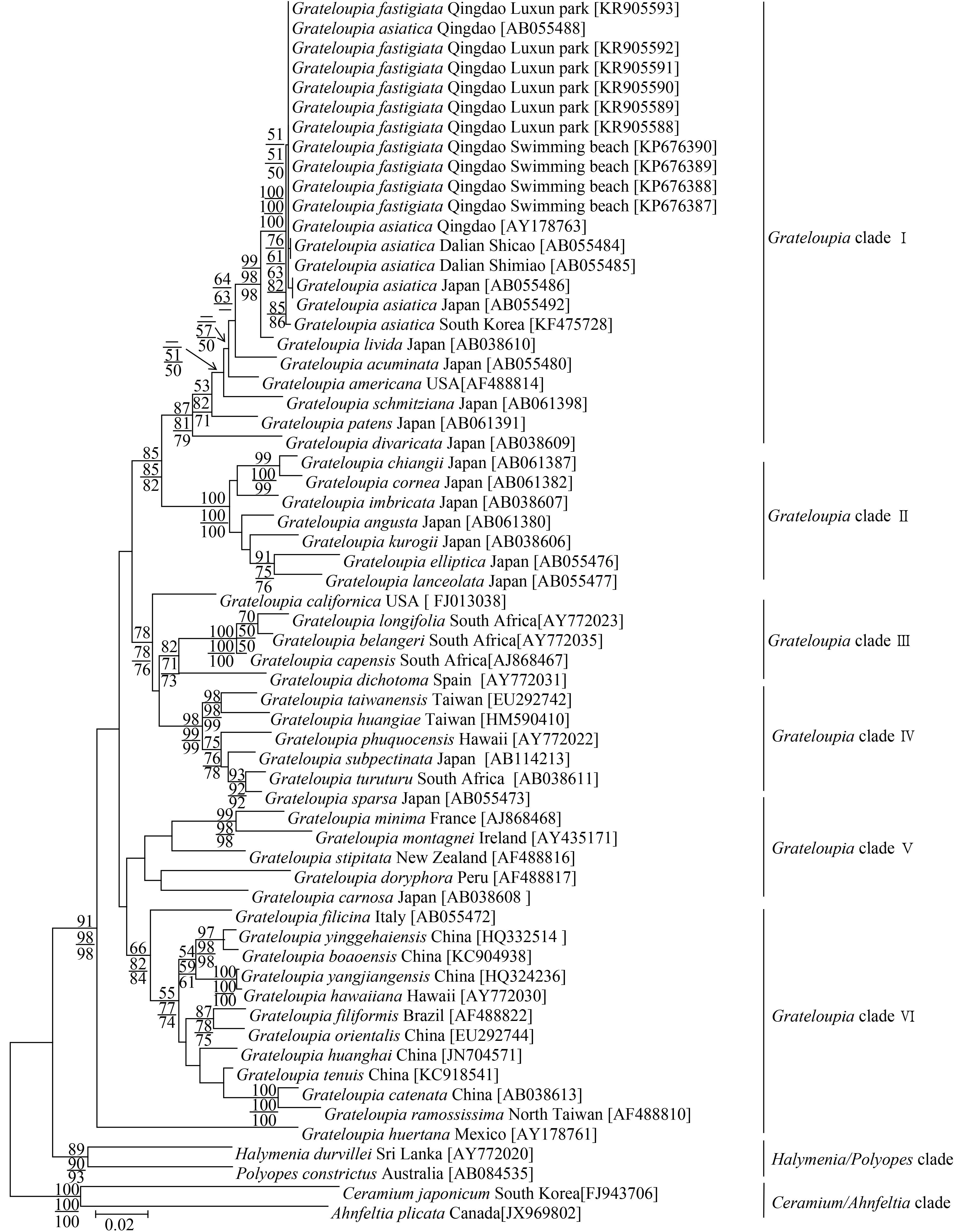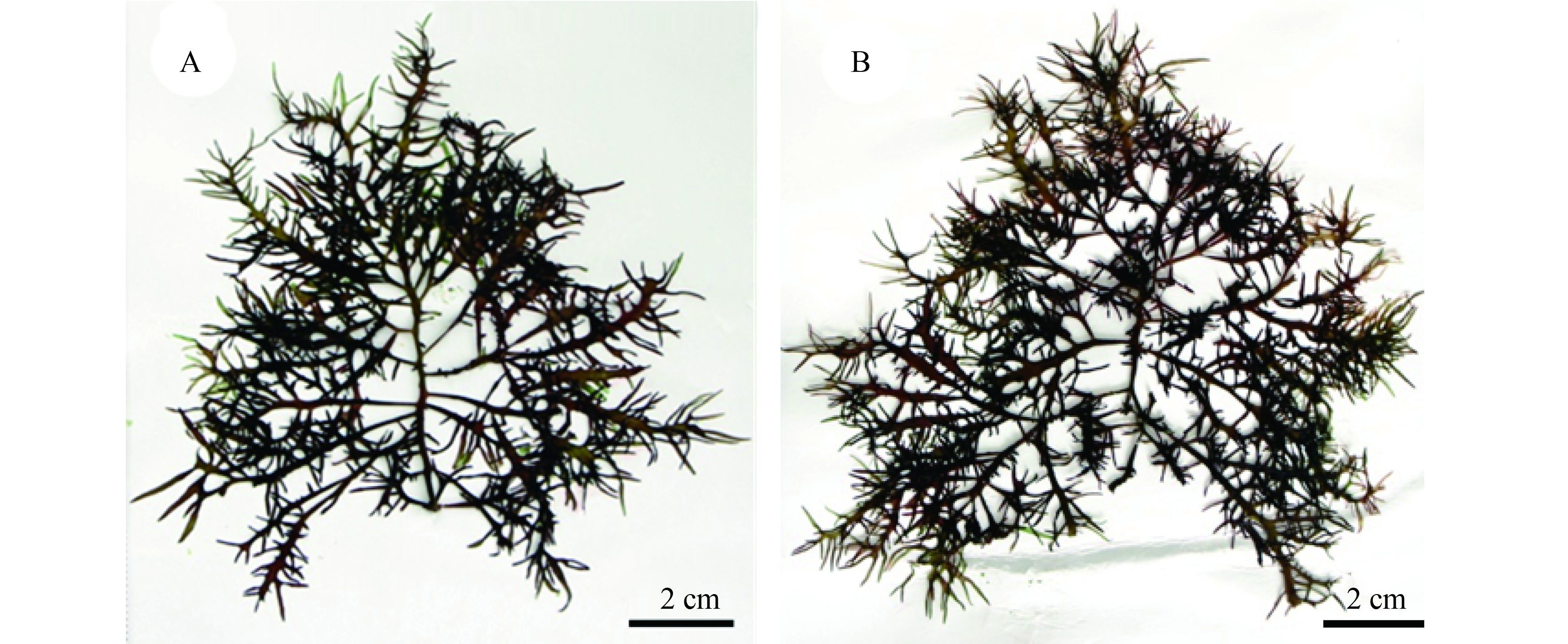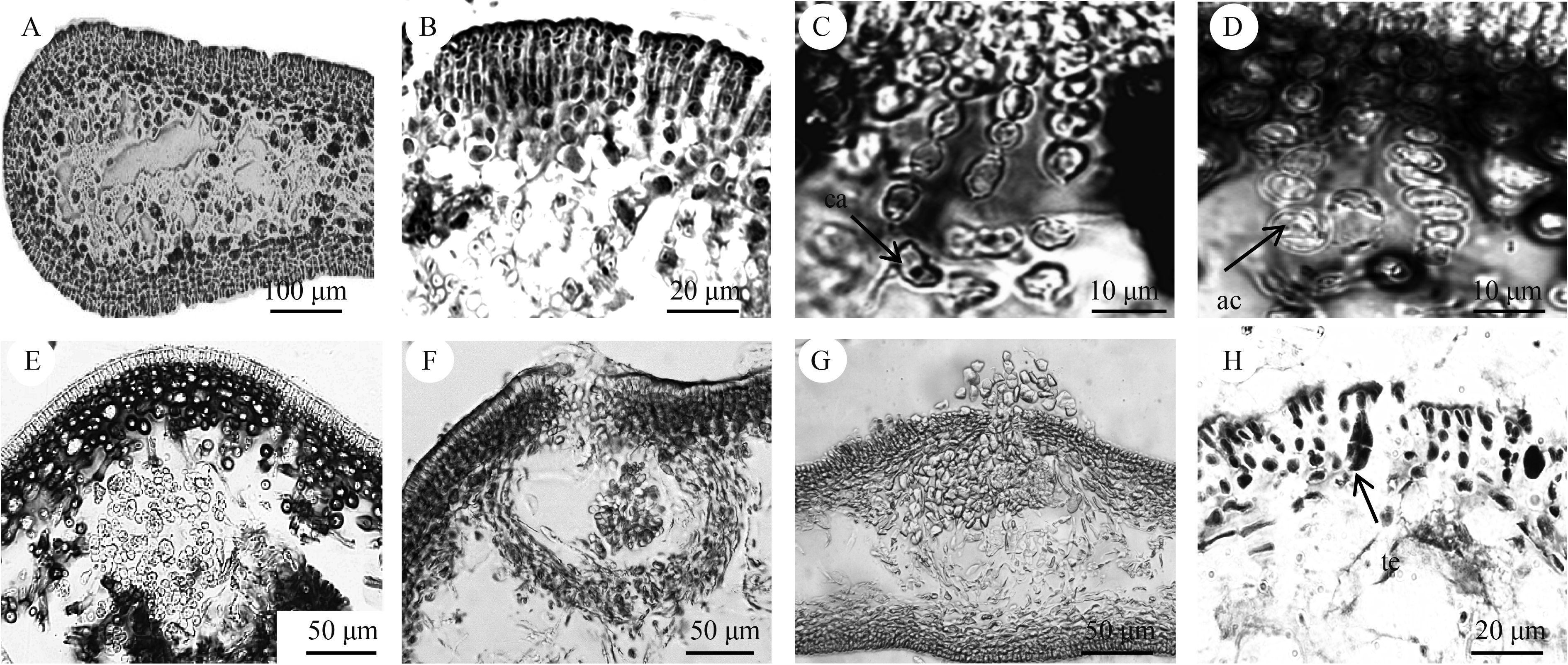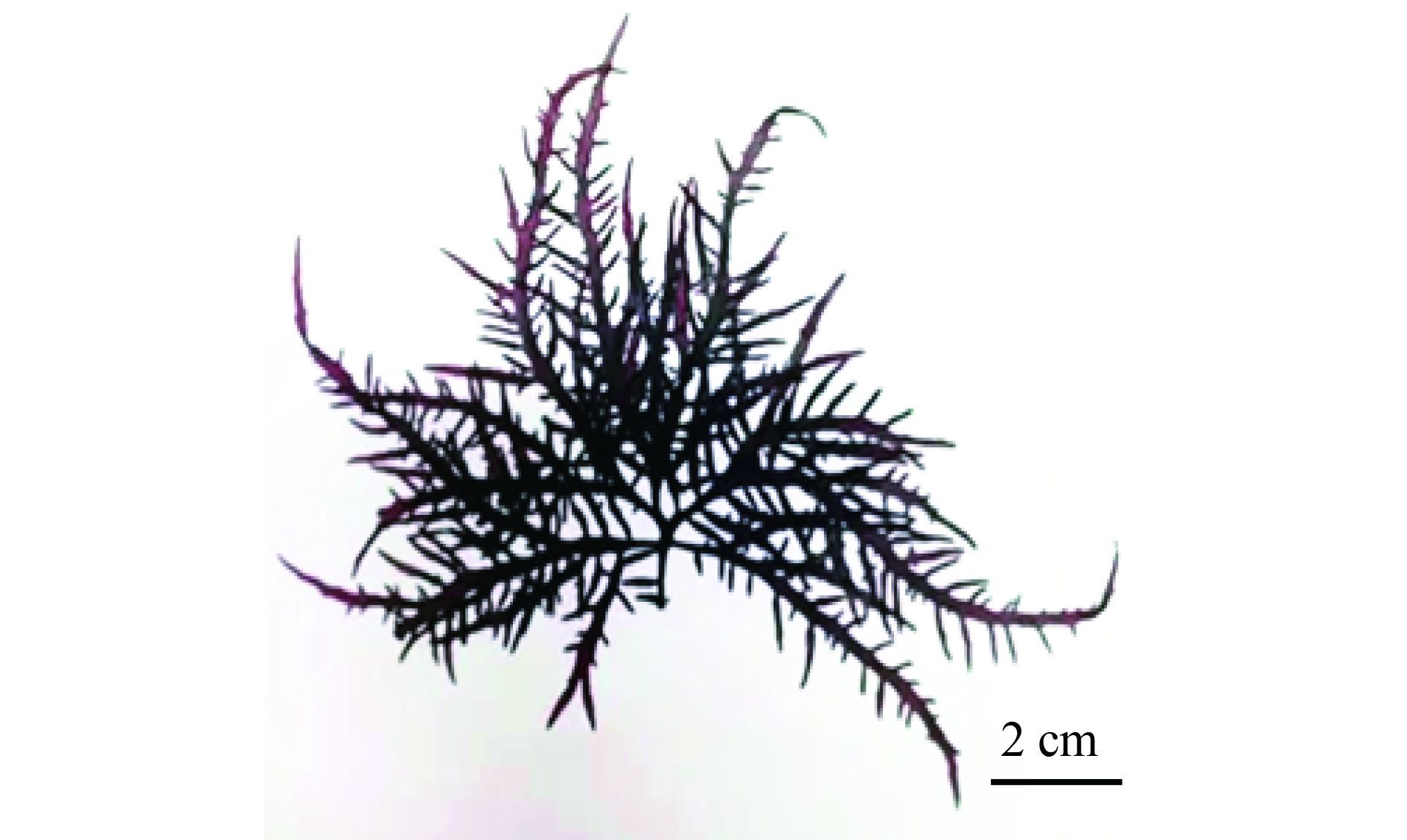RESEARCH ON THE REVISION OF GRATELOUPIA FASTIGIATA LI ET DING (RHODOPHYTA, HALYMENIACEAE) BASED ON MORPHOLOGICAL OBSERVATIONS AND RBCL SEQUENCE ANALYSES
-
摘要: 通过形态观察和分子分析相结合的方法,对青岛(模式标本产地)产的帚状蜈蚣藻(Grateloupia fastigiata Li et Ding)进行了重新鉴定,结果表明:①藻体为深紫红色,高9-26 cm,基部呈圆柱状,1-2回不规则羽状分枝,皮层厚度为85-160 μm,由8-11层细胞构成;助细胞生殖枝丛为典型的Grateloupia型,果胞枝生殖枝丛主枝由6个细胞组成,辅助细胞生殖枝丛主枝由5个细胞组成(6cpb-5auxb型),与亚洲蜈蚣藻(G.asiatica Kawaguchi et Wang)一致。②基于rbcL基因序列构建的系统树显示:本研究的10个帚状蜈蚣藻样本与青岛产的亚洲蜈蚣藻之间无碱基差异,形成独立的进化支,与大连石槽、石庙子产的亚洲蜈蚣藻的碱基差异均为1 bp(0.08%),与日本、韩国产的亚洲蜈蚣藻的碱基差异分别为2 bp(0.16%)、3 bp(0.24%),均属于种内差异,与Grateloupia clade I中蜈蚣藻属内其他种的碱基差异为18(1.47%)-76 bp(6.19%),均属于种间差异。通过形态观察和rbcL基因序列分析,认为帚状蜈蚣藻与亚洲蜈蚣藻为同一种,将帚状蜈蚣藻作为亚洲蜈蚣藻的异名。Abstract: By combining morphological observation with molecular analysis, Grateloupia fastigiata Li et Ding was re-examined. The results showed that:① thallus was dark purplish red, 9-26 cm high, percurrent axes terete basally, dichotomously branched once or twice, cortex sections were 85-160 m thick consisting of 8-11 layers of cells; the auxi-liary cell ampullae exhibited typical Grateloupia-type, carpogonial branch ampullae consisted of six cells, auxiliary cell ampullae consisted of five cells (6cpb-5auxb type), identical with G. asiatica Kawaguchi et Wang. ② According to the phylogenetic tree constructed by gene (rbcL) sequences, there was no sequence divergence between the ten samples of G. fastigiata examined in this research and G. asiatica from Qingdao, which formed a single monophyletic subclade within the large Grateloupia clade of Halymeniaceae, the rbcL sequences differences between it and G. asiatica from Dalian was 1 bp (0.08%), the rbcL sequences differences between it and G. asiatica from Japan and South Korea was 2 bp (0.16%) and 3 bp (0.24%), belonging to intraspecific difference, the rbcL sequences differences between it and other species within the Grateloupia clade I was 18 (1.47%)-76 bp (6.19%), belonging to interspecific difference. Through morphological observations and molecular analysis, G. fastigiata and G. asiatica proved to be the same species, with G. fastigiata as the synonym of G. asiatica.
-
Keywords:
- Rhodophyta /
- Halymeniaceae /
- Grateloupia fastigiata /
- Morphological /
- rbcL
-
蜈蚣藻属(Grateloupia C. Agardh)隶属于红藻门(Rhodophyta)杉藻目(Gigartinales)海膜科(Haly- meniaceae),由C. Agardh于1822年建立,全世界共报道有91个种,中国共报道了35个种[1-10]。该属是海膜科中最大的一个属,藻体的外部形态从细羽状到叉枝状以及叶状等变异较大,同一种的外部形态也因生态环境、地域等不同而变异很大,运用传统的形态学分类方法(例如藻体主要的分枝数、固着器的形状和大小、藻体颜色和藻体质地等)对蜈蚣藻属物种进行准确的分类鉴定较困难。1970年,Chiang[2]提出Grateloupia型的辅助细胞生殖枝丛结构是蜈蚣藻属海藻的重要鉴别特征。1984年,李伟新等[3]关于蜈蚣藻属生殖结构的报道支持Chiang的观点。2004年,Kawaguchi等[4]进一步证实了果胞枝生殖枝丛结构与辅助细胞生殖枝丛结构具有同样的分类学价值。2013年,Gargiulo等[5]在关于蜈蚣藻属的研究中,根据组成辅助细胞生殖枝丛主枝和果胞枝生殖枝丛主枝细胞数量的不同,将其分为6cpb-5auxb型、5cpb-4auxb型和4cpb-3auxb型。随着分子生物学和分子系统学的迅速发展,越来越多的国内外藻类分类学家采用传统的形态学观察与rbcL基因序列相结合的方法作为蜈蚣藻属分类鉴定的依据。例如,2000年,Wang等[6]运用形态学观察与rbcL基因序列相结合的方法,对中空变形蜈蚣藻、节荚变形蜈蚣藻和李伟新鉴定的新种管形藻[Sinotibimorpha porracea (Martens ex Kützing)Li et Ding]进行分析,认为它们是同物异名,并和属模蜈蚣藻[G. filicina (Lamouroux)C. Agardh]进行了比较研究,认为其既不是蜈蚣藻的变形也不是新种,而是蜈蚣藻属中的一个独立种,恢复了G. catenata Yendo。2001年,Kawaguchi等[7]通过对亚洲和意大利(模式标本产地)产的属模蜈蚣藻[G. filicina (La- mouroux) C. Agardh]进行形态结构和rbcL基因序列对比研究,发现二者并非为同一种,认为亚洲产的蜈蚣藻为一新种,将其命名为: 亚洲蜈蚣藻(G. asiatica Kawaguchi et Wang)。上述学者的研究均表明运用rbcL基因序列结合形态学观察,可以对外部形态相似,易造成混淆的蜈蚣藻进行较为准确的区分,对仅根据外部形态和内部生殖结构而错误分类的蜈蚣藻,进行准确的鉴定和并种。证明rbcL基因序列在蜈蚣藻属的种间鉴定中,具有较高的准确性。本课题组运用rbcL基因序列结合形态学观察已经发现并报道了莺歌海蜈蚣藻(G. yinggehaiensis Wang et Luan)[8]、大连蜈蚣藻(G. dalianensis Wang et Zhao)[8]、细弱蜈蚣藻(G. tenuis Wang et luan)[9]、博鳌蜈蚣藻(G. boaoensis Wang et Luan)[10]、黄海蜈蚣藻(G. huanghaiensis Wang et Zhao)[11]等新种并且对阳江蜈蚣藻(G. yangjiangensis Li et Ding)[12]进行了再鉴定。本研究的帚状蜈蚣藻(G. fastigiata Li et Ding)是李伟新等[3]基于简单的外部形态描述和少量的内部生殖结构观察记载于2004年出版夏邦美主编的《中国海藻志》第二卷第三册中的一新种[1],据《中国海藻志》记载,该种区别于其他种的主要特征为: 藻体主枝基部呈圆柱形,分枝基部不缢缩,披针形的小羽枝聚集于主枝上部,呈帚状。关于帚状蜈蚣藻的研究仅限于《中国海藻志》中的记载,相关的分子序列分析、详细的内部生殖结构观察等研究均未见报道。为了进一步验证帚状蜈蚣藻的分类地位,主要对帚状蜈蚣藻的辅助细胞生殖枝丛结构、果胞枝生殖枝丛结构、受精后的发育过程、囊果的发育过程、四分孢子囊形态进行详细的研究,同时,对帚状蜈蚣藻的rbcL基因序列进行详细系统分析。
1. 材料与方法
1.1 样品的采集、处理和形态学观察
帚状蜈蚣藻于2013年6月26日采自模式标本产地山东省青岛市的第一海水浴场和鲁迅公园(表 1)。制作成硅胶干燥标本用于提取DNA、腊叶标本用于形态观察和10%福尔马林溶液液浸标本制作冰冻切片。冰冻切片用0.5% (w/v)的甲基蓝染色,并用Olympus BH2数字显微镜观察,用Nikon HFX-ⅡA照相机拍照记录。标本保存于辽宁师范大学生命科学学院植物标本室中(LNU)。
表 1 帚状蜈蚣藻的采集地点、标本号及基因登录号Table 1. Collection location, Specimen No. and GenBank accession number of G. fastigiata采集地点Collection locations 标本号Specimen No. 基因登录号Accession No. 中国山东省青岛市的第一海水浴场 First Swimming Beach, Qingdao, Shandong Province, China LNU20130501 KP676387 LNU20130502 KP676388 LNU20130503 KP676389 LNU20130504 KP676390 LNU20130625 KP905588 中国山东省青岛市的鲁迅公园 Luxun park, Qingdao, Shandong Province, China LNU20130626 KP905589 LNU20130627 KP905590 LNU20130628 KP905591 LNU20130629 KP905592 LNU20130630 KP905593 1.2 基因序列测定和分子序列分析
运用植物基因组DNA提取试剂盒(TIAGEN,Valencia,CA,Beijing)对硅胶干燥标本进行DNA的提取,将提取到的DNA进行PCR扩增,PCR反应条件为: 93℃预变性1min; 94℃变性30s,退火温度为50-60℃,设置6个温度梯度,时间为30s,72℃延伸45s,循环35次; 72℃最终延伸5min,4℃暂存。PCR扩增产物经1%琼脂糖凝胶电泳检测,检测后由上海生工生物公司代为纯化和测序。引物设计参照Wang等[6]并改进的方法。引物组合为: F29- R1280,F1-R646,F481-R1381 (表 2)。
表 2 rbcL序列扩增所需引物Table 2. Primers used for amplifying rbcL sequences引物Primer 方向Direction 序列Sequence (5′-3′) F29 正方向 TGTAACTCCACAGCCAGGAG R1280 反方向 GCGACCTTCATTACGTGCTA F1 正方向 CAAGGATTAAGAATGAACGCTA R646 反方向 AATCTTTCTTTCCAACGCAT F481 正方向 GTAGAACGTGAGCGTATGGA R1381 反方向 ATCTTTCCATAAATCTAAAGC 从GenBank网站下载并选取了46个种的rbcL基因序列与本研究中得到的10个基因序列进行比对分析,包括蜈蚣藻属的42个种[6-22],同科内海膜属(Halymenia C. Agardh)的Halymenia durvillei De Clerck[13],海柏属(Polyopes J. Agardh)的Polyopes constrictus (Turner) J. Agardh[23],以及仙菜目(Cera- miales)仙菜科(Ceramiaceae)仙菜属(Ceramium Roth)的日本仙菜(Ceramium japonicum)[24]和伊谷藻目(Ahnfeltlales)伊谷藻科(Ahnfeltiaceae)伊谷藻属(Ahnfeltia Fries)的皱叶伊谷藻(Ahnfeltia plicata)[25]2个种(图 4)。
![]() 图 4 基于rbcL基因构建的系统发育树比例尺为0.02; 分支上的数字表示的支持率(1000次重复)分别为ML(上)、NJ(中)、MP(下), 只显示支持率大于50%, "—"表示支持率低于50%。Ceramium japonicum Okamura和Ahnfeltia plicata (Hudson) E.M.Fries Gaillon两个种在本实验中作为外群, 且选取了44个海膜科内的种来比较。黑体字为本文研究种Figure 4. Tree was based on partial rbcL sequences dataThe scale bar is 0.02 substitutions per site; numerals at internal nodes are bootstrap values (1000 replicates) inferred from ML (upper), NJ (middle) and MP (lower). Only values above 50% bootstrap support are shown, and "—" indicates that corresponding bootstrap values are lower than 50%. Ceramium japonicum Okamura and Ahnfeltia plicata (Hudson) E.M. Fries were used as outgroups and 44 Halymeniaceae species were used for the analysis in this study. Boldfaces are the species studied in this study
图 4 基于rbcL基因构建的系统发育树比例尺为0.02; 分支上的数字表示的支持率(1000次重复)分别为ML(上)、NJ(中)、MP(下), 只显示支持率大于50%, "—"表示支持率低于50%。Ceramium japonicum Okamura和Ahnfeltia plicata (Hudson) E.M.Fries Gaillon两个种在本实验中作为外群, 且选取了44个海膜科内的种来比较。黑体字为本文研究种Figure 4. Tree was based on partial rbcL sequences dataThe scale bar is 0.02 substitutions per site; numerals at internal nodes are bootstrap values (1000 replicates) inferred from ML (upper), NJ (middle) and MP (lower). Only values above 50% bootstrap support are shown, and "—" indicates that corresponding bootstrap values are lower than 50%. Ceramium japonicum Okamura and Ahnfeltia plicata (Hudson) E.M. Fries were used as outgroups and 44 Halymeniaceae species were used for the analysis in this study. Boldfaces are the species studied in this study应用软件Clustalx (1.83) [26]进行基因序列比对。使用Neighbor joining (NJ)法、Maximum pa- rsimony (MP)法和Maximum likelihood (ML)法构建系统树。PAUP4.0[7]和MEGA5.0[27]软件用于碱基差异度的分析以及系统树的构建,计算遗传距离的模型为Number of differences和Kimura 2-Parameter,Bootstrap值为1000。
2. 结果
2.1 外部形态和内部结构
藻体为深紫红色,高9-26 cm,圆盘状固着器,表面黏滑,质地为软骨质; 1-2回不规则羽状分枝,小枝对生或互生,羽状小枝聚集于主枝上部呈帚状; 主枝扁压,基部呈圆柱状,宽约6 mm,分枝宽约2-3 mm (图 1)。囊果散布于整个藻体,稍突出藻体表面(图 2)。
藻体横切面观: 藻体由皮层及髓部构成,皮层由8-11层细胞组成,背斜排列,厚度为85-160 μm。外皮层由3-5层圆形或长椭圆形细胞构成。内皮层由5-6层不规则的多角形或星状细胞构成。中央髓丝纵走或交织,长24-63 μm,宽2-3 μm(图 3A、B)。
![]() 图 3 帚状蜈蚣藻的营养结构和生殖结构A. 藻体的横切面观; B. 藻体横切面观, 由皮层和髓部构成; C. 果胞枝生殖枝丛横切面观(ca, 果胞); D. 辅助细胞生殖枝丛横切面观(ac, 辅助细胞); E-G. 囊果连续的发育过程; E. 囊果形成的初始阶段; F. 囊果的发育阶段; G. 囊孔释放成熟的果孢子; H. 四分孢子囊呈十字形分裂(te, 四分孢子囊)Figure 3. The vegetative structure and reproductive structures of the G. fastigiataA. Cross-section of the thallus; B. Cross-section of the thallus, consisted of cortex and medulla; C. Transection of carpogonial branch ampullae (ca, auxiliary cell); D. Transection of auxiliary cell ampullae (ac, auxiliary cell); E-G. Development processes of cystocarp; E. Initial stage of cystocarp formation; F. developing cystocarp; G. Mature carpospores released from cystocarp hole; H. Tetrasporangia cross division (te, Tetrasporangia)
图 3 帚状蜈蚣藻的营养结构和生殖结构A. 藻体的横切面观; B. 藻体横切面观, 由皮层和髓部构成; C. 果胞枝生殖枝丛横切面观(ca, 果胞); D. 辅助细胞生殖枝丛横切面观(ac, 辅助细胞); E-G. 囊果连续的发育过程; E. 囊果形成的初始阶段; F. 囊果的发育阶段; G. 囊孔释放成熟的果孢子; H. 四分孢子囊呈十字形分裂(te, 四分孢子囊)Figure 3. The vegetative structure and reproductive structures of the G. fastigiataA. Cross-section of the thallus; B. Cross-section of the thallus, consisted of cortex and medulla; C. Transection of carpogonial branch ampullae (ca, auxiliary cell); D. Transection of auxiliary cell ampullae (ac, auxiliary cell); E-G. Development processes of cystocarp; E. Initial stage of cystocarp formation; F. developing cystocarp; G. Mature carpospores released from cystocarp hole; H. Tetrasporangia cross division (te, Tetrasporangia)2.2 生殖结构
藻体雌雄异体。果胞枝生殖枝丛和辅助细胞生殖枝丛均由内皮层细胞产生,果胞枝主枝由6个细胞组成,包括一个连有一条长受精丝的果胞,一个下位细胞,下位细胞连接一条由3-4个细胞组成的不育侧枝,一个卵圆形的亚下位细胞,亚下位细胞连接一个由4-6个细胞组成的不育侧枝,与之对向生长的依次是3个连接有不育侧枝的圆形细胞。果胞与大的基细胞相邻,受精丝有时伸直,有时弯曲成各种角度指向叶状体表面,果胞枝上的不育侧枝弯向叶状体表面形成瓶状体(图 3C)。
辅助细胞枝主枝由5个细胞组成,辅助细胞位于近末端。辅助细胞枝上的所有细胞都连有一个5-12个细胞的侧枝。辅助细胞枝的所有侧枝均弯向叶状体表面形成一个瓶状体,与果胞枝相似。辅助细胞位于瓶状体中心,成熟的辅助细胞形状为圆球形(图 3D)。
精子通过受精丝到达果胞,受精后的果胞增大与下位细胞融合,融合后的细胞产生一个短的初级联络丝,延伸并与果胞枝上的基细胞融合,这个融合细胞产生次级联络丝并向辅助细胞移动。
当联络丝接近辅助细胞时,它的顶部位置立刻膨胀与辅助细胞融合,从辅助细胞的近顶部或侧面长出三级联络丝,同时,辅助细胞产生一个初级产孢丝并指向叶状体表面生长,产孢丝上的细胞逐渐形成孢子囊。成熟的囊果近球形,被3-5层髓丝环绕,髓丝和营养丝发育成果被,孢子囊的末端具有囊孔,果孢子是由产孢丝末端细胞形成的,待成熟后由囊孔逸出。囊果微突出藻体表面且呈现肉眼可见的斑点状,散落于除基部外整个藻体。囊果的纵切面观,直径60-90 μm (图 3E-G)。四分孢子囊由皮层的第三或第四层细胞形成,十字形分裂,长为37-49 μm,宽为15-21 μm (图 3H)。
2.3 rbcL基因序列分析
帚状蜈蚣藻的10个rbcL基因序列长度均为1380 bp,由于选取其他种的序列的5′端和3′端不完整,比对的基因序列长度为1226 bp。
由MAGE5所得到的矩阵图的序列比对结果: 10个帚状蜈蚣藻的基因序列之间无碱基差异,与该种遗传距离最近的是青岛产的亚洲蜈蚣藻,它们之间无碱基差异,与大连、日本、韩国产的亚洲蜈蚣藻的碱基差异分别为1 bp (0.08%)、2 bp (0.16%)、3 bp (0.24%),在第一个进化支中聚集成独立的小分支,区别于其他种,帚状蜈蚣藻和亚洲蜈蚣藻形成的独立小支与舌状蜈蚣藻(G. livida)、美国蜈蚣藻(G. americana)、顶状蜈蚣藻(G. acuminata)、史氏蜈蚣藻(G. schmitziana)、伸展蜈蚣藻(G. patens)、叉枝蜈蚣藻(G. divaricata)的碱基差异分别为18 (1.47%)-19 bp (1.55%)、35 (2.85%)-36 bp (2.93%)、35 (2.85%)-37 bp (3.02%)、49 (3.99%)-51 bp (4.16%)、44 (3.59%)-46 bp (3.75%)、73 (5.95%)-76 bp (6.19%),与产自意大利的属模蜈蚣藻(G. filicina)的碱基差异为82 (6.68%)-87 bp (7.09%)。与海柏属的Polyopes constrictus、海膜属的Halymenia dur- villei之间的碱基差异分别为121 (9.87%)-123 bp (10.03%)、124 (10.11%)-126 bp (10.28%),与作为外群的日本仙菜(Ceramium japonicum)和皱叶伊谷藻(Ahnfeltia plicata)的碱基差异分别为173 (14.11%)-177 bp (14.44%)、175 (14.27%)-177 bp (14.44%)。
ML法、NJ法和MP法所构建的系统树的树形比较相似,均以ML系统树代表。系统树分为三个大的分支,分别为蜈蚣藻属分支、海膜属和海柏属分支、仙菜属和伊谷藻属分支,均得到Bootstrap高度支持。在蜈蚣藻属这一大分支中,由于种间的基因序列差异,又分为6个小分支,本文研究的10个帚状蜈蚣藻样本与亚洲蜈蚣藻聚集在一起,在第一个小分支中形成单独的分支,最大支持率为99%,同时位于第一个小分支中的还有舌状蜈蚣藻(G. livida)、美国蜈蚣藻(G. americana)、顶状蜈蚣藻(G. acumi- nata)、史氏蜈蚣藻(G. schmitziana)、伸展蜈蚣藻(G. patens)、叉枝蜈蚣藻(G. divaricata),支持率高达87%。
3. 讨论
通过1226 bp的rbcL基因序列分析结果显示,帚状蜈蚣藻与青岛产的亚洲蜈蚣藻之间无碱基差异,与大连石槽、石庙产的亚洲蜈蚣藻的碱基差异为1 bp (0.08%),与日本、韩国产的亚洲蜈蚣藻之间的碱基的差异分别为2 bp (0.16%)和3 bp(0.24%),2000年,Wang等[6]在链状蜈蚣藻的再鉴定中指出,六个采集地点的链状蜈蚣藻之间的碱基差异为0-0.1%,并表明由于采集地点的不同,蜈蚣藻属红藻同种内会存在很小的碱基差异; 2009年,Lee等[28] 提出蜈蚣藻属红藻在rbcL基因序列分析下的种内差异为0-1.0%。因此,帚状蜈蚣藻与亚洲蜈蚣藻之间的碱基差异为0-0.24%,属于种内差异。
形态观察结果表明: 帚状蜈蚣藻与亚洲蜈蚣藻(图 5)藻体的颜色均为紫红色,高度基本一致,在9-30 cm,质地为软骨质,主枝基部呈圆柱状,分枝基部不缢缩,皮层数在7-11层,髓部非中空。2013年,Gargiulo 等[5]在关于蜈蚣藻属的生殖结构和受精后早期发育的研究中,认为亚洲蜈蚣藻的生殖结构为6cpb-5auxb型,果胞枝主枝由6个细胞组成,辅助细胞枝主枝由5个细胞组成,果胞仅与下位细胞融合,辅助细胞没有融合现象,在我们观察的帚状蜈蚣藻的生殖结构的细胞组成数量以及受精后的早期发育与亚洲蜈蚣藻完全一致。二者仅在藻体分枝部分有较小区别: 帚状蜈蚣藻为1-2回不规则羽状分枝,小枝分布较密集,聚集于主枝上部呈帚状; 亚洲蜈蚣藻主枝为二叉分枝,小枝为羽状分枝,小枝分布较稀疏(表 3)。由于同一种海藻的外部形态也因生态环境、海域以及采集时间等不同而变异很大,由此导致二者在外部形态上略有差异。藻体的成熟期和生长盛期也是蜈蚣藻的重要鉴定分类依据,帚状蜈蚣藻与亚洲蜈蚣藻的藻体成熟期均在6月末-7月初,生长盛期均为6月-9月。
表 3 帚状蜈蚣藻和亚洲蜈蚣藻的形态比较Table 3. Comparison of morphological features between G. fastigiata and G. asiatica帚状蜈蚣藻G. fastigiata 亚洲蜈蚣藻G. asiatica 外部形态 Morphological of thallus 藻体直立, 紫红色, 高9-26 cm, 主枝扁压, 基部不缢缩, 呈圆柱状, 宽2-3 mm; 1-2回不规则羽状分枝 藻体直立, 紫红色, 高10-30 cm, 主枝扁压, 基部不缢缩, 呈圆柱状, 宽2-5 mm; 主枝二叉分枝, 小枝不规则羽状分枝 质地Texture 软骨质 软骨质 皮层数Cortex 8-11层 7-10层 四分孢子囊形态和大小 Shape and size of tetrasporangia: length-width (μm) 长椭圆形: (37-49) μm×(15-21) μm 长椭圆形: (40-50) μm×(15-20) μm 髓部Medulla 非中空 非中空 配子体Gametophytes 雌雄异体 雌雄异体 分布Distributions 中国青岛 中国大连、青岛 辅助细胞生殖枝丛类型Auxiliary cell ampullae Grateloupia型 (6cap-5auxb) Grateloupia型 (6cap-5auxb) 成熟期Mature stage 7月初 6月末-7月初 生长盛期Vigorous growth period 6-9月 6-9月 文献References 本研究; 夏邦美, 2004 Kawaguchi et al., 2001 通过以上分析讨论,提出帚状蜈蚣藻与亚洲蜈蚣藻为同一种,亚洲蜈蚣藻为Kawaguchi等[7]于2001年报道,帚状蜈蚣藻无相关文献报道,仅夏邦美于2004年记载于《中国海藻志》,根据优先法则,将帚状蜈蚣藻作为亚洲蜈蚣藻的异名,本研究为《中国海藻志》的再版提供可靠信息。
-
图 4 基于rbcL基因构建的系统发育树
比例尺为0.02; 分支上的数字表示的支持率(1000次重复)分别为ML(上)、NJ(中)、MP(下), 只显示支持率大于50%, "—"表示支持率低于50%。Ceramium japonicum Okamura和Ahnfeltia plicata (Hudson) E.M.Fries Gaillon两个种在本实验中作为外群, 且选取了44个海膜科内的种来比较。黑体字为本文研究种
Figure 4. Tree was based on partial rbcL sequences data
The scale bar is 0.02 substitutions per site; numerals at internal nodes are bootstrap values (1000 replicates) inferred from ML (upper), NJ (middle) and MP (lower). Only values above 50% bootstrap support are shown, and "—" indicates that corresponding bootstrap values are lower than 50%. Ceramium japonicum Okamura and Ahnfeltia plicata (Hudson) E.M. Fries were used as outgroups and 44 Halymeniaceae species were used for the analysis in this study. Boldfaces are the species studied in this study
图 3 帚状蜈蚣藻的营养结构和生殖结构
A. 藻体的横切面观; B. 藻体横切面观, 由皮层和髓部构成; C. 果胞枝生殖枝丛横切面观(ca, 果胞); D. 辅助细胞生殖枝丛横切面观(ac, 辅助细胞); E-G. 囊果连续的发育过程; E. 囊果形成的初始阶段; F. 囊果的发育阶段; G. 囊孔释放成熟的果孢子; H. 四分孢子囊呈十字形分裂(te, 四分孢子囊)
Figure 3. The vegetative structure and reproductive structures of the G. fastigiata
A. Cross-section of the thallus; B. Cross-section of the thallus, consisted of cortex and medulla; C. Transection of carpogonial branch ampullae (ca, auxiliary cell); D. Transection of auxiliary cell ampullae (ac, auxiliary cell); E-G. Development processes of cystocarp; E. Initial stage of cystocarp formation; F. developing cystocarp; G. Mature carpospores released from cystocarp hole; H. Tetrasporangia cross division (te, Tetrasporangia)
表 1 帚状蜈蚣藻的采集地点、标本号及基因登录号
Table 1 Collection location, Specimen No. and GenBank accession number of G. fastigiata
采集地点Collection locations 标本号Specimen No. 基因登录号Accession No. 中国山东省青岛市的第一海水浴场 First Swimming Beach, Qingdao, Shandong Province, China LNU20130501 KP676387 LNU20130502 KP676388 LNU20130503 KP676389 LNU20130504 KP676390 LNU20130625 KP905588 中国山东省青岛市的鲁迅公园 Luxun park, Qingdao, Shandong Province, China LNU20130626 KP905589 LNU20130627 KP905590 LNU20130628 KP905591 LNU20130629 KP905592 LNU20130630 KP905593 表 2 rbcL序列扩增所需引物
Table 2 Primers used for amplifying rbcL sequences
引物Primer 方向Direction 序列Sequence (5′-3′) F29 正方向 TGTAACTCCACAGCCAGGAG R1280 反方向 GCGACCTTCATTACGTGCTA F1 正方向 CAAGGATTAAGAATGAACGCTA R646 反方向 AATCTTTCTTTCCAACGCAT F481 正方向 GTAGAACGTGAGCGTATGGA R1381 反方向 ATCTTTCCATAAATCTAAAGC 表 3 帚状蜈蚣藻和亚洲蜈蚣藻的形态比较
Table 3 Comparison of morphological features between G. fastigiata and G. asiatica
帚状蜈蚣藻G. fastigiata 亚洲蜈蚣藻G. asiatica 外部形态 Morphological of thallus 藻体直立, 紫红色, 高9-26 cm, 主枝扁压, 基部不缢缩, 呈圆柱状, 宽2-3 mm; 1-2回不规则羽状分枝 藻体直立, 紫红色, 高10-30 cm, 主枝扁压, 基部不缢缩, 呈圆柱状, 宽2-5 mm; 主枝二叉分枝, 小枝不规则羽状分枝 质地Texture 软骨质 软骨质 皮层数Cortex 8-11层 7-10层 四分孢子囊形态和大小 Shape and size of tetrasporangia: length-width (μm) 长椭圆形: (37-49) μm×(15-21) μm 长椭圆形: (40-50) μm×(15-20) μm 髓部Medulla 非中空 非中空 配子体Gametophytes 雌雄异体 雌雄异体 分布Distributions 中国青岛 中国大连、青岛 辅助细胞生殖枝丛类型Auxiliary cell ampullae Grateloupia型 (6cap-5auxb) Grateloupia型 (6cap-5auxb) 成熟期Mature stage 7月初 6月末-7月初 生长盛期Vigorous growth period 6-9月 6-9月 文献References 本研究; 夏邦美, 2004 Kawaguchi et al., 2001 -
[1] 夏邦美. 中国海藻志. 见:第二卷红藻门, 第三册石花菜目隐丝藻目胭脂藻目. 北京:科学出版社. 2004, 59-81 Xia B M. Flora Algarum Marinarum Sinicarum[A]. In:Tomus II Rhodophyta. Part III. Gelidiales Cryptonemiales Hildenbrandiales[C]. Beijing:Science Press. 2004, 59-81
夏邦美. 中国海藻志. 见:第二卷红藻门, 第三册石花菜目隐丝藻目胭脂藻目. 北京:科学出版社. 2004, 59-81[2] Chiang Y M. Morphological studies of the red algae of the family Cryptonemiaceae[J]. University of California Publications in Botany, 1970, 58:1-95 http://cn.bing.com/academic/profile?id=562098517&encoded=0&v=paper_preview&mkt=zh-cn
[3] 李伟新, 付鹏飞, 丁镇芬, 等. 蜈蚣藻及其生殖器官的研究. 热带海洋, 1984, 3(4):35-40 http://www.cnki.com.cn/Article/CJFDTOTAL-RDHY198404004.htm Li W X, Fu P F, Ding Z F, et al. Studies on the reproductive organs of Grateloupia filicina (MU LF) C. AG[J]. Tropic Oceanology, 1984, 3(4):35-40
李伟新, 付鹏飞, 丁镇芬, 等. 蜈蚣藻及其生殖器官的研究. 热带海洋, 1984, 3(4):35-40 http://www.cnki.com.cn/Article/CJFDTOTAL-RDHY198404004.htm[4] Kawaguchi S, Shimada S, Wang H W, et al. The new genus Yonagunia Kawaguchi et Masuda (Halymeniaceae, Rhodophyta), based on Y. tenuifolia Kawaguchi et Masuda sp. nov. from southern Japan and including Y. formosana (Okamura) Kawaguchi et Masuda comb. nov. from Southeast Asia[J]. Phycologia, 2004, 40(1):180-192 doi: 10.1046/j.1529-8817.2004.03077.x
[5] Gargiulo G M, Morabito M, Manghisi A. A re-assessment of reproductive anatomy and postfertilization development in the systematics of Grateloupia (Halymeniales, Rhodophyta)[J]. Cryptogamie, Algologie, 2013, 34(1):3-35 doi: 10.7872/crya.v34.iss1.2013.3
[6] Wang H W, Kawaguchi S, Horiguchi T, et al. Reinstatement of Grateloupia catenata (Rhodophyta, Halymeniaceae) on the basis of morphology and rbcL sequences[J]. Phycologia, 2000, 39(3):228-237 doi: 10.2216/i0031-8884-39-3-228.1
[7] Kawaguchi S, Wang H W, Horiguchi T, et al. A comparative study of the red alga Grateloupia filicina (Halymeniaceae) from the northwestern Pacific and Mediterranean with the description of Grateloupia asiatica sp. nov.[J]. Phycologia, 2001, 37(3):433-442 doi: 10.1046/j.1529-8817.2001.037003433.x
[8] Zhao D, Wang H W, Sheng Y W, et al. Morphological observation and rbcL gene sequences studies of two new species, Grateloupia dalianensis H. W. Wang et D. Zhao, sp. nov. and G. yinggehaiensis H. W. Wang et R. X. Luan, sp. nov. (Halymeniaceae, Rhodophyta) from China[J]. Acta Oceanological Sinica, 2012, 31(2):109-120 doi: 10.1007/s13131-012-0197-9
[9] Yu L, Wang H W, Luan R X. Grateloupia tenuis Wang et Luan sp. nov. (Halymeniaceae, Rhodophyta):a new species from South China Sea based on morphological observation and rbcL gene sequences analysis[J]. Biomed Research International, Published online 2013 Dec 23. doi: 10.1155/2013/560163
[10] Liu M, Wang H W, Luan R X. Morphological observation and rbcL sequence analysis of a new species from China, Grateloupia boaoensis Wang et Luan sp. nov. (Halymeniaceae, Rhodophyta)[J]. Acta Hydrobiologica Sinica, 2014, 38(5):939-944 http://cn.bing.com/academic/profile?id=2357605142&encoded=0&v=paper_preview&mkt=zh-cn
[11] Guan Y, Wang H W, Zhao F Q, et al. Grateloupia huanghaiensis sp. nov. (Halymeniaceae, Rhodophyta), a peculiar new species from China[J]. Marine Biology Research, 2015, 11(4):396-404 doi: 10.1080/17451000.2014.932913
[12] Wang H W, Guo S R, Zhang X M, et al. Re-identifying Grateloupia yangjiangensis (Rhodophyta, Halymeniaceae) based on morphological observations, life history and rbcL sequence analyses[J]. Acta Oceanological Sinica, 2014, 33(4):77-84 doi: 10.1007/s13131-014-0450-5
[13] De Clerck O, Gavio B, Fredericq S, et al. Systematics of Grateloupia filicina (Halymeniaceae, Rhodophyta), based on rbcL sequence analyses and morphological evidence, including the reinstatement of G. minima and the description of G. capensis sp. nov.[J]. Phycologia, 2005, 41(2):391-410 doi: 10.1111/(ISSN)1529-8817
[14] Gavio B, Fredericq S. Grateloupia turuturu (Halymeniaceae, Rhodophyta) is the correct name of the non-native species in the Atlantic known as Grateloupia doryphora[J]. European Journal of Phycology, 2002, 37(3):349-360 doi: 10.1017/S0967026202003839
[15] Mateo-Cid L E, Mendoza-González A C, Gavi B, et al. Grateloupia huertana sp. nov. (Halymeniaceae, Rhodophyta), a peculiar new prostrate species from tropical Pacific Mexico[J]. Phycologia, 2005, 44(1):4-16 doi: 10.2216/0031-8884(2005)44[4:GHSNHR]2.0.CO;2
[16] Lin X M, Liang H Y, M H Hommersand. Two types of auxiliary cell ampullae in Grateloupia (Halymeniaceae, Rhodophyta), including G. taiwanensis sp. nov. and G. orientalis sp. nov. from Taiwan based on rbcL gene sequence analysis and cystocarp development[J]. Journal of Phycologia, 2008, 44(1):196-214 doi: 10.1111/jpy.2008.44.issue-1
[17] Faye E T, Wang H W, Kawaguchi S, et al. Reinstatement of Grateloupia subpectinata (Rhodophyta, Halymeniaceae) based on morphology and rbcL sequences[J]. Phycological, 2004, 52(1):59-67 doi: 10.1111/pre.2004.52.issue-1
[18] Miller K A, Hughey J R, Gabrielson P W. Research note:First report of the Japanese species Grateloupia lanceolata (Halymeniaceae, Rhodophyta) from California, USA[J]. Phycological Research, 2009, 57(3):238-241 doi: 10.1111/j.1440-1835.2009.00542.x
[19] Wang H W, Kawaguchi S, Horiguchi T, et al. A morphological and molecular assessment of the genus Prionitis J. Agardh (Halymeniaceae, Rhodophyta)[J]. Phycological Research, 2001, 49(3):251-261 doi: 10.1111/pre.2001.49.issue-3
[20] Wilkes R J, McIvor L M, Guiry M D. Using rbcL sequence data to reassess the taxonomic position of some Grateloupia and Dermocorynus species (Halymeniaceae, Rhodophyta) from the northeastern Atlantic[J]. European Journal of Phycology, 2005, 40(1):53-60 doi: 10.1080/09670260400024634
[21] De Clerck O, Gavio B, Fredericq S, et al. Systematic reassessment of the red algal genus Phyllymenia (Halymeniaceae, Rhodophyta)[J]. European Journal of Phycology, 2005, 40(2):169-178 doi: 10.1080/09670260500128343
[22] Lin X M, Liang H Y. Grateloupia huangiae (Halymeniaceae, Rhodophyta), a new species from Taiwan previously confused with Polyopes lancifolius, with emphasis on the development of the auxiliary-cell ampullae[J]. Phycologia, 2011, 50(3):232-240 doi: 10.2216/10-29.1
[23] Kawaguchi S, Wang H W, Horiguchi T, et al. Rejection of Sinkoraena and transfer of some species of Carpopeltis and Sinkoraena to Polyopes (Rhodophyta, Halymeniaceae)[J]. Phycologia, 2002, 41(6):619-635 doi: 10.2216/i0031-8884-41-6-619.1
[24] Yang E C, Boo S M. Molecular evidence for recolonization of Ceramium japonicum (Ceramiaceae, Rhodophyta) on the west coast of Korea after the last glacial maximum[J]. Journal of Phycology, 2001, 37(3):433-442 doi: 10.1046/j.1529-8817.2001.037003433.x
[25] Dixon K R, Saunders G W. DNA barcoding and phylogenetics of Ramicrusta and Incendia gen. nov., two early diverging lineages of the Peyssonneliaceae (Rhodophyta)[J]. Phycologia, 2013, 52(1):82-108 doi: 10.2216/12-62.1
[26] Wei Z H, Zhu M L, Yu G L, et al. Occurrence of planktonic cyanobacterium Tychonema bourrellyi in Erhai Lake and its taxonomic studies[J]. Acta Hydrobiologica Sinica, 2012, 36(6):1171-1175 http://cn.bing.com/academic/profile?id=2364385636&encoded=0&v=paper_preview&mkt=zh-cn
[27] 卫志宏, 朱梦灵, 虞功亮, 等. 洱海的浮游蓝藻布氏常丝藻及其分类学的讨论. 水生生物学报, 2012, 36(6):1171-1175 doi: 10.1093/molbev/msr121
[28] Koichiro T, Daniel P, Nicholas P, et al. MEGA5:Molecular evolutionary genetics analysis using maximum likelihood, evolutionary distance, and maximum parsimony methods[J]. Molecular Biology and Evolution, 2011, 28(10):2731-2739 doi: 10.4490/ALGAE.2009.24.4.231
-
期刊类型引用(9)
1. 王惠娜,卞瑶,丁媛媛,李晶蕊,刘婧,王宏伟. 缢基蜈蚣藻的修订——基于形态观察、早期发育及分子序列分析. 水生生物学报. 2021(03): 670-679 .  本站查看
本站查看
2. 温馨,卞瑶,张昕陶,马跃,王晨,王宏伟. 聚果蜈蚣藻的修订——基于形态观察、早期发育及分子序列分析. 水生生物学报. 2021(06): 1331-1340 .  本站查看
本站查看
3. 马跃,卞瑶,温馨,张昕陶,王宏伟. 中国伞形蜈蚣藻和亚栉状蜈蚣藻的合种研究——基于形态观察、早期发育及分子分析. 水生生物学报. 2021(06): 1361-1370 .  本站查看
本站查看
4. 陈素文,冯彬,李婷,张博,朱长波,杨贤庆. 蜈蚣藻属生物学与养殖研究进展. 南方水产科学. 2019(01): 119-123 .  百度学术
百度学术
5. 冯彬,李婷,张博,朱长波,苏家齐,陈素文,杨贤庆. 广东汕头南澳和福建东山浮筏的蜈蚣藻属调查. 南方水产科学. 2019(05): 48-54 .  百度学术
百度学术
6. 李晓丽,芦莹,胡玉才,孙丕海,邢冬飞. 高压静电场激励裙带菜配子体的生物效应研究. 大连海洋大学学报. 2018(04): 413-422 .  百度学术
百度学术
7. 依朋,宋学文,娄宇,王宏伟. 海南新纪录种台湾蜈蚣藻(红藻门)的形态学观察和rbcL与COI基因序列分析. 海洋与湖沼. 2018(03): 604-613 .  百度学术
百度学术
8. PENG Chong,DING Haiyan,TANG Zhihong,GUO Li,YANG Guanpin. Molecular Grouping of Grateloupia Tissues Collected Along Chinese Coast and Microsatellite Diversity Analysis of G. asiatica. Journal of Ocean University of China. 2018(04): 925-931 .  必应学术
必应学术
9. 刘芳,田伊林,王宏伟. 对枝蜈蚣藻的修订研究——基于形态特征和基因序列分析. 水生生物学报. 2017(06): 1273-1281 .  本站查看
本站查看
其他类型引用(4)



 下载:
下载:




